Supporting Sustainable Development by Identifying Ways to Enhance and Conserve Local Food Wisdom, Loei Province, Thailand
Abstract
:1. Introduction
2. Materials and Methods
2.1. Study Site
2.2. Data Collectors
2.3. Participants and Data Collection
2.3.1. Semi-Structured Interviews
2.3.2. Focus Group Discussions
2.4. Construction of a Local Food Database
- Stage 1. Project Planning: This involved the first stakeholder group (software analysts; n = 3), who conducted meetings to plan database development. The feasibility of the database development schedule was studied before establishing a team (recruitment of assistant software analysts) and constructing the database according to the plan;
- Stage 2. Analysis: The software analysts evaluated other databases and studied user needs (what information they would like to see) and usage issues to guide program design. The system development life cycle (SDLC) was used to guide this process;
- Stage 3. Design: The software team designed a prototype database system. This consisted of a database, output, input, and user interface. Potential users (n = 12) then tried out the prototype; they included local people of Loei province, computer experts, researchers, and research assistants. The software team adjusted the database system in response to their feedback;
- Stage 4. Implementation: The software team implemented the database system on android operating systems and tested its performance before installing it and conducting sessions with users. The system was set, and the team compiled a user manual, trained the users, then assessed the database. Any problems encountered were solved;
- Stage 5. Maintenance: New features were added to the system, and support was provided to user tasks together with system maintenance.
2.5. Data Analysis
2.6. Ethical Considerations
3. Results
3.1. Participant Characteristics
3.2. Variety of Local Food and Food Preparation Methods
“My family like to cook kaeng nor mai [bamboo shoot curry]. It is a typical recipe in Phukradung subdistrict as there is a lot of bamboo in the national park. People here cook bamboo shoot with ear mushroom, pumpkin, okra, climbing wattle, and hairy basil leaf.”[LP42]
“In Kokthong subdistrict, people like to add different types of mushroom to kaeng nor mai [bamboo shoot curry], such as khonkhaw mushroom and grey oyster mushroom.”[LP08]
“My family always add square zucchini and ceylon spinach to kaeng nor mai [bamboo shoot curry].”[LP12]
“Jaew dam [chili dip containing fermented sathorn leaf extract] is a very common dip in Dan Sai subdistrict. We pound roasted dried chili, onion and garlic, and add salt and extracted sathorn juice for seasoning.”[LP22]
“My family like to eat mok pla [fish grilled in banana leaf]. It is very easy to prepare and cook. I only mix minnow fish with salt, monosodium glutamate and hairy basil leaf. I then wrap it in a banana leaf and grill it for about 10 min.” [LP39] Specific ingredients, namely kaffir lime leaf, lemongrass, galangal, and ginger, were used only in grilled banana leaf wrap recipes that contained either: spicy ground fish, fishroe, frog, tadpole, cricket, or pork.
“Mushroom sup [pounded mushroom] is a dish that I like to cook. I boil ear mushroom and snakebean and pound these ingredients with roasted sesame seeds and chili powder. I season it with fish sauce, fermented fish sauce, and monosodium glutamate and serve it with spring onions on top.”[LP44]
“People here like to cook larb tao [spicy-ground water silk salad] as we can get it [water silk] from the Khong [Mekong] river. I pound grilled mackerel and mix it with water silk, galangal, ground roasted rice, and season it with chili powder and fermented fish sauce and serve it with chopped spring onion and coriander.”[LP18]
“My family likes to eat ping pla khaw [grilled swamp barb]. We usually get it from a swamp near our rice field. We can get it when we want to eat ping pla khaw. I just only add some salt and then grill it.”[LP44]
3.3. Ways to Increase the Value of Local Food
3.3.1. Nutritional Value
“Although I have my own garden, I still buy ingredients from the market as the variety of vegetables I grow in my garden is less than the variety available at the market. Sometimes I even buy prepared ingredients as it is convenient, and it saves money.”[LP10]
“In my hometown [Dan Sai subdistrict], most householders use sathorn sauce, naturally fermented plant juice, rather than fish sauce.”[LP28]
“People here normally cook banana blossom curry with either fresh catfish or snakehead fish. I sometimes cook it with dried squid or dried minced fish, if I cannot get fresh catfish or snakehead fish.”[LP86]
“I also cook banana blossom curry with scallops or clams depending on which are available.”[LP38]
“In rainy season, my family collects a lot of bamboo shoot from the forest and we cannot eat them all. Therefore, we preserve the bamboo shoots by fermenting them.”[LP4]
“Yes, me too. However, we cannot keep it [the fermented bamboo] for too long as it spoils.”[LP41]
“Most people here like to get some frogs and bullfrogs at night after the rain as they come out to the ground. Some people sell them as there are a lot and some are grilled and dried to keep them for a longer time.”[LP52]
“It can be made in to fermented bullfrog too.”[LP56]
“I sometimes add some leaves called oomsab [Chinese violet] to a curry. It makes the curry naturally sweet and delicious. If we add these leaves, we do not need to add monosodium glutamate to our curry.”[LP22]
“I like to have bamboo curry with different types of mushroom. They are good for the body.”[LP4]
“Some families add another vegetable in the curry such as plang [ceylon spinach].”[LP26]
“Recently, a lot of pesticides have been widely used in our community to increase plant quality and quantity” [LP1], “especially by the local people who grow vegetables for sale in the market.”[LP2]
“Even if I do not use chemical pesticides in my kitchen garden, my neighbour uses chemical pesticides. These could contaminate my home-grown vegetables anyway.”[LP3]
3.3.2. Social Value
“I’m usually the one that’s mainly responsible for family cooking.”[LP4]
“In the former days, we mostly cooked at home. Recently, I sometimes buy cooked meals from the local market on my lazy days as it is quicker and easier.”[LP15]
“I sell side dishes in my community. I usually use a blender to grind soaked sticky rice as I can make it quicker with a larger amount.”[LP38]
“Nowadays, young people are more likely to work in the city, making the local north-eastern way of life, where relatives normally eat together, not as strong as it used to be.”[LP2]
“On a local community event day, most people in our village help each other for cooking and we have meals in the event area.”[LP14]
3.3.3. Economic Value
“Yes, I do [sell local food]. I cook some local dishes such as larb moo (spicy minced pork salad), papaya salad, some curry, and so on. I don’t earn much money as my shop is small and I can’t sell it at a higher price.”[LP74]
“Some restaurants here use betel palm container for serving food, but the cost is high and local people can’t invest in that.”[LP52]
“Most customers are local people. If they were tourists, they would go to a big restaurant with a more attractively presented food menu set for them.”[LP72]
“I’ve been to Chiangkan walking street market. The food on sale there are very appetising as they are colourful.”[LP25]
3.4. Local Food Database
4. Discussion
4.1. Variety of Local Food and Food Preparation Methods
4.2. Ways to Increase the Value of Local Food
4.2.1. Nutritional Value
4.2.2. Social Value
4.2.3. Economic Value
4.3. Limitations and Strengths
5. Conclusions
Author Contributions
Funding
Institutional Review Board Statement
Informed Consent Statement
Data Availability Statement
Acknowledgments
Conflicts of Interest
References
- Morton, S.; Pencheon, D.; Squires, N. Sustainable Development Goals (SDGs), and their implementation: A national global framework for health, development and equity needs a systems approach at every level. Br. Med. Bull. 2017, 124, 81–90. [Google Scholar] [CrossRef] [PubMed]
- The Global Goals: 2. Zero Hunger. Available online: https://www.globalgoals.org/2-zero-hunger (accessed on 20 February 2022).
- Open Development Thailand. Sustainable Development Goals. 2018. Available online: https://thailand.opendevelopmentmekong.net/topics/sustainable-development-goals/#:~:text=The%20six%20areas%20are%3A%20security,justice%20and%20reduce%20social%20disparities (accessed on 20 February 2022).
- The World Bank in Thailand: Overview. Available online: https://www.worldbank.org/en/country/thailand/overview#1 (accessed on 20 February 2022).
- Sugiyarto, G.; Agunias, D.R. A “Freer” Flow of Skilled Labor within ASEAN: Aspirations, Opportunities and Challenges in 2015 and Beyond; International Organization for Migration and Migration Policy Institute: Bangkok, Thailand; Washington, DC, USA, 2014; Available online: https://www.migrationpolicy.org/sites/default/files/publications/MPI-IOM-Issue-No-11-Skilled-Labour-Movement.pdf (accessed on 20 February 2022).
- Sani, M.A.M. The challenges of social media in ASEAN communities. J. Commun. Innov. NIDA 2015, 2, 1–24. Available online: https://so02.tci-thaijo.org/index.php/jcin/article/view/47733 (accessed on 20 February 2022).
- Pruksa, S.; Sripoona, S.; Makhanpan, I.; Luengam, P. Biodiversity of local foods and their nutrient values in Na O Cultural Village, Na O District, Loei Province. J. Community Dev. Life Qual. 2020, 8, 352–365. Available online: https://shorturl.at/eiH28 (accessed on 20 February 2022). (In Thai).
- Popkin, B.M. Global nutrition dynamics: The world is shifting rapidly toward a diet linked with noncommunicable diseases. Am. J. Clin. Nutr. 2006, 84, 289–298. [Google Scholar] [CrossRef]
- Elizabeth, K.E. Nutrition and malnutrition. In The Encyclopedia of Child and Adolescent Development; Hupp, S., Jewell, J., Eds.; John Wiley and Sons, Inc.: New, York, NY, USA, 2019. [Google Scholar]
- Thailand: The Burden of Malnutrition at a Glance. Global Nutrition Report 2021. Available online: https://globalnutritionreport.org/resources/nutrition-profiles/asia/south-eastern-asia/thailand/ (accessed on 20 February 2022).
- Okubo, T.; Janmohamed, A.; Topothai, C.; Blankenship, J.L. Risk factors modifying the double burden of malnutrition of young children in Thailand. Matern. Child Nutr. 2020, 2, e12910. [Google Scholar] [CrossRef]
- Health Promotion: Nutrition Information (Loei Province). 2021. Available online: https://lei.hdc.moph.go.th/hdc/reports/page.php?cat_id=46522b5bd1e06d24a5bd81917257a93c (accessed on 21 April 2022).
- Kelly, A.S.; Lu, X. From land-locked to land-linked? In Critical Landscape Planning during the Belt and Road Initiative; Kelly, A.S., Lu, X., Eds.; Springer: Singapore, 2021. [Google Scholar] [CrossRef]
- Pupiupa, P.; Mattariganond, D. The establishment of Vientiane as the new capital of the Lan Xang Kingdom in the reign of King Xaysetthathirath (1560–1571 A.D.). J. Mekong Soc. 2021, 17, 46–67. Available online: https://so03.tci-thaijo.org/index.php/mekongjournal/article/view/245652 (accessed on 20 February 2022).
- Benchawattananon, R. Biodiversity of mushrooms in conservative forest in Dansai District of Loei Province, Thailand. Trop. Life Sci. Res. 2016, 27, 103–109. [Google Scholar] [CrossRef] [PubMed]
- Wangpimool, W.; Pongput, K.; Tangtham, N.; Prachansri, S.; Gassman, P.W. The impact of para rubber expansion on streamflow and other water balance components of the Nam Loei river basin, Thailand. Water 2017, 9, 1. [Google Scholar] [CrossRef] [Green Version]
- Lao, R.; Parks, T.; Sangvirojkul, C.; Lek-Uthai, A.; Pathanasethpong, A.; Arporniem, P.; Takkhin, T.; Tiamsai, K. Thailand’s Inequality: Myths and Reality of Isan; The Asia Foundation: San Francisco, CA, USA, 2019; Available online: https://asiafoundation.org/publication/thailands-inequality-myths-reality-of-isan/ (accessed on 20 February 2022).
- Theerapaksiri, P.; Trakansiriwanich, K.; Tanupol, N.; Inthajak, M. The competency of agro-eco tourism management leaders of Pla-ba community-based tourism club, Loei Province. Dusit Thani Coll. J. 2020, 14, 110–128. Available online: https://so01.tci-thaijo.org/index.php/journaldtc/article/view/245496 (accessed on 20 February 2022).
- Food and Agriculture Organization. Food Diversity Expresses Cultural Heritage and is Key for Dietary Diversity; Food and Agriculture Organization: Quebec City, QC, Canada, 2018; Available online: https://www.fao.org/news/story/en/item/1171702/icode/ (accessed on 21 April 2022).
- Food Security Information Network. Global Report on Food Crises, 3rd ed.; Food and Agriculture Organization of the United Nations: Quebec City, QC, Canada, 2018; Available online: https://www.fao.org/emergencies/resources/documents/resources-detail/en/c/1107313/ (accessed on 15 February 2022).
- Bubpa, N.; Nuntaboot, K. Diversity of foods among older people in northern communities of Thailand: Ways to promote health and wellness. J. Health Res. 2018, 32, 95–104. [Google Scholar] [CrossRef] [Green Version]
- Department of Provincial Administration. Population Numbers of Thailand Based on Civil Registration 2018. Available online: https://stat.bora.dopa.go.th/stat/pk/pk_61.pdf (accessed on 11 April 2022).
- National News Bureau of Thailand. Loei Special Area DASTA Office Explores Tourist Routes and Community Tourism Activities. Available online: https://thainews.prd.go.th/th/news/print_news/TCATG220316164002533 (accessed on 4 May 2022).
- Lune, H.; Berg, B.L. Use of triangulation in research methodology. In Qualitative Research Methods for the Social Sciences, 9th ed.; Dodge, A., Ed.; Pearson Education: Harlow, UK, 2017. [Google Scholar]
- Guion, L.A. Triangulation: Establishing the validity of qualitative studies. Document FCS6014; Department of Family, Youth and Community Sciences, Florida Cooperative Extension Service, Institute of Food and Agricultural Sciences, University of Florida: Gainesville, FL, USA, 2002; Available online: https://sites.duke.edu/niou/files/2014/07/W13-Guion-2002-Triangulation-Establishing-the-Validity-of-Qualitative-Research.pdf (accessed on 5 April 2022).
- Lune, H.; Berg, B.L. Stages in the content analysis process. In Qualitative Research Methods for the Social Sciences, 9th ed.; Dodge, A., Ed.; Pearson Education: Harlow, UK, 2017. [Google Scholar]
- Pragattakomol, P.; Taylor, K. The evolution of cultural landscape and built environment through Thai food and way of living: The case study of Central region of Thailand. Dusit Thani Coll. J. 2018, 12, 124–149. Available online: https://so01.tci-thaijo.org/index.php/journaldtc/article/view/118030 (accessed on 20 February 2022).
- Huebbe, P.; Rimbach, G. Historical reflection of food processing and the role of legumes as part of a healthy balanced diet. Foods 2020, 9, 1056. [Google Scholar] [CrossRef] [PubMed]
- Watanasin, R. Central Thai food culture and acculturation during World War II and the Vietnam war. Manusya: J. Humanit. 2020, 23, 205–223. [Google Scholar] [CrossRef]
- Harmayani, E.; Anal, A.K.; Wichienchot, S.; Bhat, R.; Gardjito, M.; Santoso, U.; Siripongvutikorn, S.; Puripaatanavong, J.; Payyappallimana, U. Healthy food traditions of Asia: Exploratory case studies from Indonesia, Thailand, Malaysia, and Nepal. J. Ethn. Foods 2019, 6, 1. [Google Scholar] [CrossRef] [Green Version]
- Chiramongkolgarn, U. Indigenous Vegetables: Know Vegetables, Know How to Eat; Baanlaesuan Printing Company: Bangkok, Thailand, 2004. [Google Scholar]
- Wang, M.C.; Naidoo, N.; Ferzacca, S.; Reddy, G.; Van Dam, R.M. The role of women in food provision and food choice decision-making in Singapore: A case study. Ecol. Food Nutr. 2014, 53, 658–677. [Google Scholar] [CrossRef] [Green Version]
- Monterrosa, E.C.; Frongillo, E.A.; Drewnowski, A.; de Pee, S.; Vandevijvere, S. Sociocultural influences on food choices and implications for sustainable healthy diets. Food Nutr. Bull. 2020, 41, 59S–73S. [Google Scholar] [CrossRef]
- Wong, K.M. Bamboo the Amazing Grass: A Guide to the Diversity and Study of Bamboos in South-East Asia; International Plant Genetic Resources Institute (IPGR) and University of Malaya: Rome, Italy, 2004; Available online: https://www.bioversityinternational.org/fileadmin/_migrated/uploads/tx_news/Bamboo_the_amazing_grass__a_guide_to_the_diversity_and_study_of_bamboos_in_Southeast_Asia_917.pdf (accessed on 27 March 2022).
- Cruz-Garcia, G.S.; Price, L.L. Gathering of wild food plants in anthropogenic environments across the seasons: Implications for poor and vulnerable farm households. Ecol. Food Nutr. 2014, 53, 363–389. [Google Scholar] [CrossRef]
- Ghosh-Jerath, S.; Singh, A.; Magsumbol, M.S.; Lyngdoh, T.; Kamboj, P.; Goldberg, G. Contribution of indigenous foods towards nutrient intakes and nutritional status of women in the Santhal tribal community of Jharkhand, India. Public Health Nutr. 2016, 19, 2256–2267. [Google Scholar] [CrossRef] [Green Version]
- Sang-ngoen, D.; Hutchinson, C.; Satheannoppakao, W.; Tipayamongkholgul, M. Food consumption and accessibility in hill tribe and urban women, Chiang Rai province, northern Thailand. Ecol. Food Nutr. 2019, 58, 335–352. [Google Scholar] [CrossRef] [PubMed]
- Weisskopf, A.R. Elusive wild foods in South East Asian subsistence: Modern ethnography and archaeological phytoliths. Quat. Int. 2018, 489, 80–90. [Google Scholar] [CrossRef]
- Cruz-Garcia, G.S.; Price, L.L. Ethnobotanical investigation of ‘wild’ food plants used by rice farmers in Kalasin, Northeast Thailand. J. Ethnobiol. Ethnomed. 2011, 7, 33. [Google Scholar] [CrossRef] [PubMed] [Green Version]
- Sitthiwong, N. Pigment and nutritional value of Spirogyra spp. in Sakon Nakhon, Nakhon Phanom and Mukdahan Provinces. Sci. Technol. RMUTT J. 2019, 9, 10–21. [Google Scholar] [CrossRef]
- Chadseesuwan, U.; Puthong, S.; Deetae, P. Growth promotion of some lactic acid bacteria by crude extract of Spirogyra sp., Cladophora sp., Caulerpa lentillifera and Caulerpa corynephora. Food Res. 2020, 4, 81–86. [Google Scholar] [CrossRef]
- Siripongvutikorn, S.; Thummaratwasik, P.; Huang, Y.W. Antimicrobial and antioxidation effects of Thai seasoning, Tom-Yum. LWT-Food Sci. Technol. 2005, 38, 347–352. [Google Scholar] [CrossRef]
- Nanasombat, S.; Yansodthee, K.; Jongjaited, I. Evaluation of antidiabetic, antioxidant and other phytochemical properties of Thai fruits, vegetables and some local food plants. Walailak J. Sci. Technol. 2019, 16, 851–866. [Google Scholar] [CrossRef]
- Saikia, S.; Mahanta, C.L. In vitro physicochemical, phytochemical and functional properties of fiber rich fractions derived from by-products of six fruits. J. Food Sci. Technol. 2016, 53, 1496–1504. [Google Scholar] [CrossRef] [PubMed] [Green Version]
- Bhaskar, J.J.S.M.; Chilkunda, N.D.; Salimath, P.V. Banana (Musa sp. var. elakki bale) flower and pseudostem: Dietary fiber and associated antioxidant capacity. J. Agric. Food Chem. 2012, 60, 427–432. [Google Scholar] [CrossRef] [PubMed]
- Padumanonda, T.; Suntornsuk, L.; Gritsanapan, W. Quantitative analysis of barakol content in Senna siamea leaves and flowers by TLC-densitometry. Med. Princ. Pract. 2007, 16, 47–52. [Google Scholar] [CrossRef]
- Coelho, F.C.; Coelho, E.M.; Egerer, M. Local food: Benefits and failings due to modern agriculture. Sci. Agric. 2018, 75, 84–94. [Google Scholar] [CrossRef] [Green Version]
- Panuwet, P.; Siriwong, W.; Prapamontol, T.; Ryan, P.B.; Fiedler, N.; Robson, M.G.; Barr, D.B. Agricultural pesticide management in Thailand: Situation and population health risk. Environ. Sci. Policy 2012, 17, 72–81. [Google Scholar] [CrossRef] [PubMed] [Green Version]
- Giampieri, F.; Mazzoni, L.; Cianciosi, D.; Alvarez-Suarez, J.M.; Regolo, L.; Sánchez-González, C.; Capocasa, F.; Xiao, J.; Mezzetti, B.; Battino, M. Organic vs conventional plant-based foods: A review. Food Chem. 2022, 383, 132352. [Google Scholar] [CrossRef]
- Hongsibsong, S.; Prapamontol, T.; Xu, T.; Hammock, B.D.; Wang, H.; Chen, Z.J.; Xu, Z.L. Monitoring of the organophosphate pesticide chlorpyrifos in vegetable samples from local markets in northern Thailand by developed immunoassay. Int. J. Environ. Res. Public Health 2020, 17, 4723. [Google Scholar] [CrossRef] [PubMed]
- Wanwimolruk, S.; Phopin, K.; Boonpangrak, S.; Prachayasittikul, V. Food safety in Thailand 4: Comparison of pesticide residues found in three commonly consumed vegetables purchased from local markets and supermarkets in Thailand. Peer J. 2016, 4, e2432. [Google Scholar] [CrossRef] [PubMed]
- Liu, L.; Zheng, X.; Wei, X.; Kai, Z.; Xu, Y. Excessive application of chemical fertilizer and organophosphorus pesticides induced total phosphorus loss from planting causing surface water eutrophication. Sci. Rep. 2021, 11, 23015. [Google Scholar] [CrossRef]
- Rusmevichientong, P.; Morales, C.; Castorena, G.; Sapbamrer, R.; Seesen, M.; Siviroj, P. Dietary salt-related determinants of hypertension in rural northern Thailand. Int. J. Environ. Res. Public Health 2021, 18, 377. [Google Scholar] [CrossRef] [PubMed]
- Mopoung, R.; Singkong, W.; Thongfak, K.; Onkeaw, M.; Boonphong, S. Nutrient and mineral composition in krathon leaves and unseasoned krathon sauce. NU Int. J. Sci. 2007, 4, 188–194. (In Thai) [Google Scholar]
- Mopoung, R.; Thongfak, K.; Somran, S.; Boonphong, S.; Singkong, W. Factors affecting the storage of krathon sauce. NU Int. J. Sci. 2009, 6, 56–63. [Google Scholar]
- Yongsmith, B.; Malaphan, W. Traditional Fermented Foods in Thailand. In Integrating Food Science and Engineering Knowledge into the Food; ChainKristbergsson, K., Oliveira, J., Eds.; Springer: Boston, MA, USA, 2016. [Google Scholar] [CrossRef]
- Sivamaruthi, B.S.; Kesika, P.; Chaiyasut, C. Thai fermented foods as a versatile source of bioactive microorganisms: A comprehensive review. Sci. Pharm. 2018, 86, 37. [Google Scholar] [CrossRef] [Green Version]
- Kelly, M.; Banwell, C.; Dixon, J.; Seubsman, S.A.; Yiengprugsawan, V.; Sleigh, A. Nutrition transition, food retailing and health equity in Thailand. Australas Epidemiol. 2010, 17, 4–7. [Google Scholar] [PubMed]
- Bipasha, M.S.; Goon, S. Fast food preference and food habit among university students of private universities in Bangladesh. South East Asia J. Public Health 2013, 3, 61–64. [Google Scholar] [CrossRef] [Green Version]
- Seubsman, S.A.; Kelly, M.; Yuthapornpinit, P.; Sleigh, A. Cultural resistance to fast-food consumption? A study of youth in North Eastern Thailand. Int. J. Consum. Stud. 2009, 33, 669–675. [Google Scholar] [CrossRef] [Green Version]
- Patcheep, K. Factors influencing urban adolescents’ eating behavior, Ratchaburi province, Thailand: An application of the Theory of Planned Behavior. J. Health Res. 2015, 29, 441–447. [Google Scholar] [CrossRef]
- Herman, C.P.; Polivy, J.; Pliner, P.; Vartanian, L.R. Effects of Social Eating. In Social Influences on Eating; Springer: Cham, Switzerland, 2019. [Google Scholar] [CrossRef]
- Lines, L.A.; Yellowknives Dene First Nation Wellness Division; Jardine, C.G. Connection to the land as a youth-identified social determinant of Indigenous Peoples’ health. BMC Public Health 2019, 19, 176. [Google Scholar] [CrossRef]
- Cueva, K.; Speakman, K.; Neault, N.; Richards, J.; Lovato, V.; Parker, S.; Carroll, D.; Sundbo, A.; Barlow, A. Cultural connectedness as obesity prevention: Indigenous youth perspectives on feast for the future. J. Nutr. Educ. Behav. 2020, 52, 632–639. [Google Scholar] [CrossRef]
- McKelvie-Sebileau, P.; Rees, D.; Tipene-Leach, D.; D’Souza, E.; Swinburn, B.; Gerritsen, S. Community co-design of regional actions for children’s nutritional health combining indigenous knowledge and systems thinking. Int. J. Environ. Res. Public Health 2022, 19, 4936. [Google Scholar] [CrossRef]
- Glover, D.; Sumberg, J. Youth and food systems transformation. Front. Sustain. Food Syst. 2020, 4, 101. [Google Scholar] [CrossRef]
- Pruksa, S.; Sripoona, S. Healthy food consumption behaviors of elderly in Na-o subdistrict, Muang district, Loei province. J. Res. Dev. Inst. Loei Rajabhat Univ. 2017, 12, 58–67. (In Thai) [Google Scholar]
- Wadhera, D.; Capaldi-Phillips, E.D. A review of visual cues associated with food-on-food acceptance and consumption. Eat. Behav. 2014, 15, 132–143. [Google Scholar] [CrossRef]
- Ezeudu, O.B.; Agunwamba, J.C.; Ezeudu, T.S.; Ugochukwu, U.C.; Ezeasor, I.C. Natural leaf-type as food packaging material for traditional food in Nigeria: Sustainability aspects and theoretical circular economy solutions. Environ. Sci. Pollut. Res. 2021, 28, 8833–8843. [Google Scholar] [CrossRef]
- Barone, A.S.; Matheus, J.; de Souza, T.; Moreira, R.; Fai, A. Green-based active packaging: Opportunities beyond COVID-19, food applications, and perspectives in circular economy—A brief review. Compr. Rev. Food Sci. Food Saf. 2021, 20, 4881–4905. [Google Scholar] [CrossRef]
- Tan, C.; Han, F.; Zhang, S.; Li, P.; Shang, N. Novel bio-based materials and applications in antimicrobial food packaging: Recent advances and future trends. Int. J. Mol. Sci. 2021, 22, 9663. [Google Scholar] [CrossRef] [PubMed]
- Royal Thai Embassy, Singapore. What Is OTOP? Available online: Shorturl.at/gqyMN (accessed on 27 May 2022).
- Dan Sai District Community Development Office, Loei. Community Development Department Ministry of the Interior. One Tambon One Product (OTOP). Available online: https://district.cdd.go.th/dansai/service/one-tambon-one-product/ (accessed on 27 May 2022).
- Park, E.; Muangasame, K.; Kim, S. ‘We and our stories’: Constructing food experiences in a UNESCO gastronomy city. Tour. Geogr. 2021. [Google Scholar] [CrossRef]
- Kaimook, N.; Suwanpratest, O. From local wisdom to tourist set menus: A case study of Ban Thung Luang, Kirimas district, Sukhothai and Ban Wang Won, Srisatchanalai district, Sukhothai. J. Community Dev. Res. (Humanit. Soc. Sci.) 2020, 13, 118–127. [Google Scholar] [CrossRef]
- Walter, P. Culinary tourism as living history: Staging, tourist performance and perceptions of authenticity in a Thai cooking school. J. Herit. Tour. 2017, 12, 365–379. [Google Scholar] [CrossRef]
 ), north-eastern Thailand (Source: CartoGIS Services, College of Asia and the Pacific, The Australian National University; CC BY SA).
), north-eastern Thailand (Source: CartoGIS Services, College of Asia and the Pacific, The Australian National University; CC BY SA).
 ), north-eastern Thailand (Source: CartoGIS Services, College of Asia and the Pacific, The Australian National University; CC BY SA).
), north-eastern Thailand (Source: CartoGIS Services, College of Asia and the Pacific, The Australian National University; CC BY SA).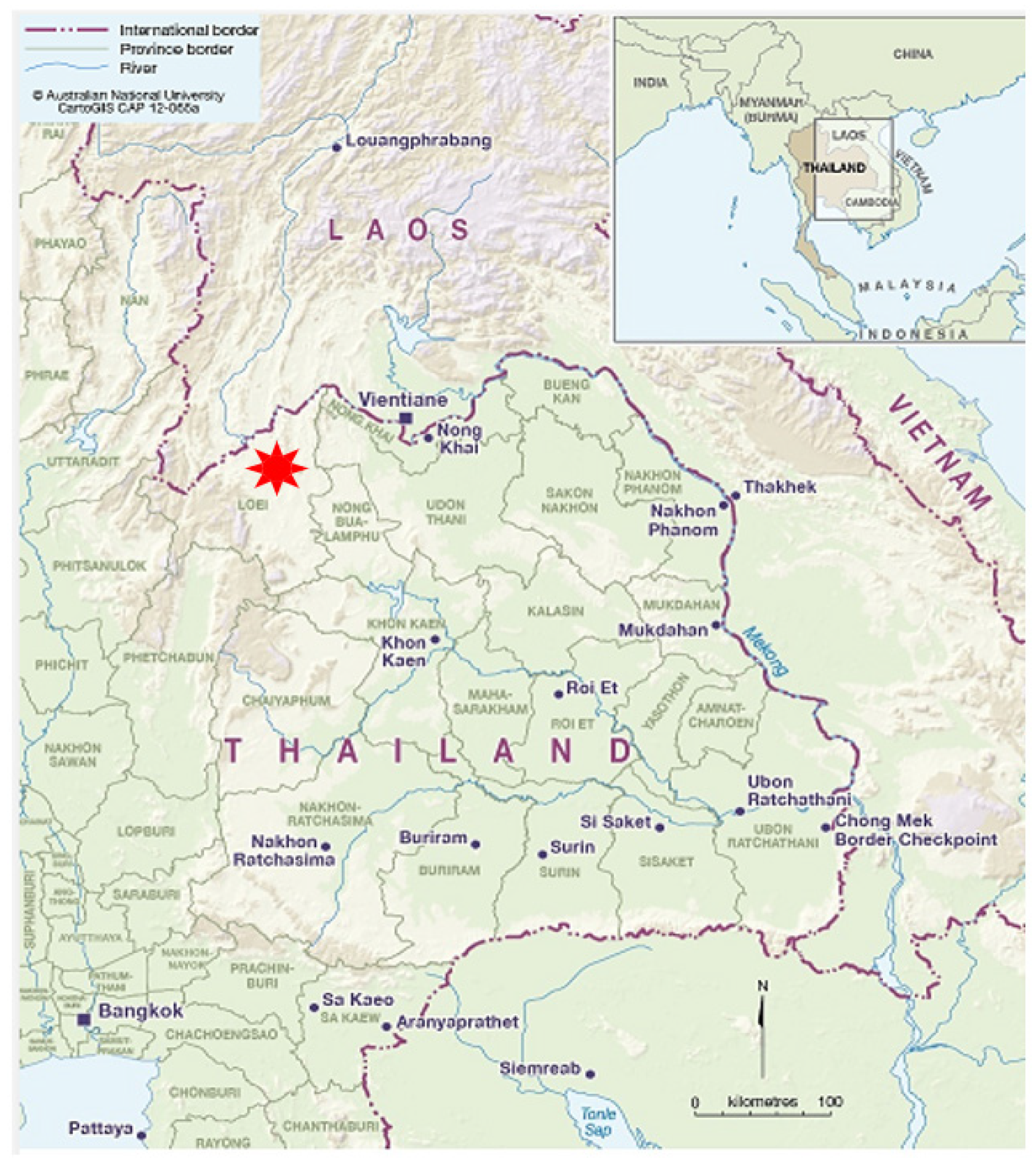
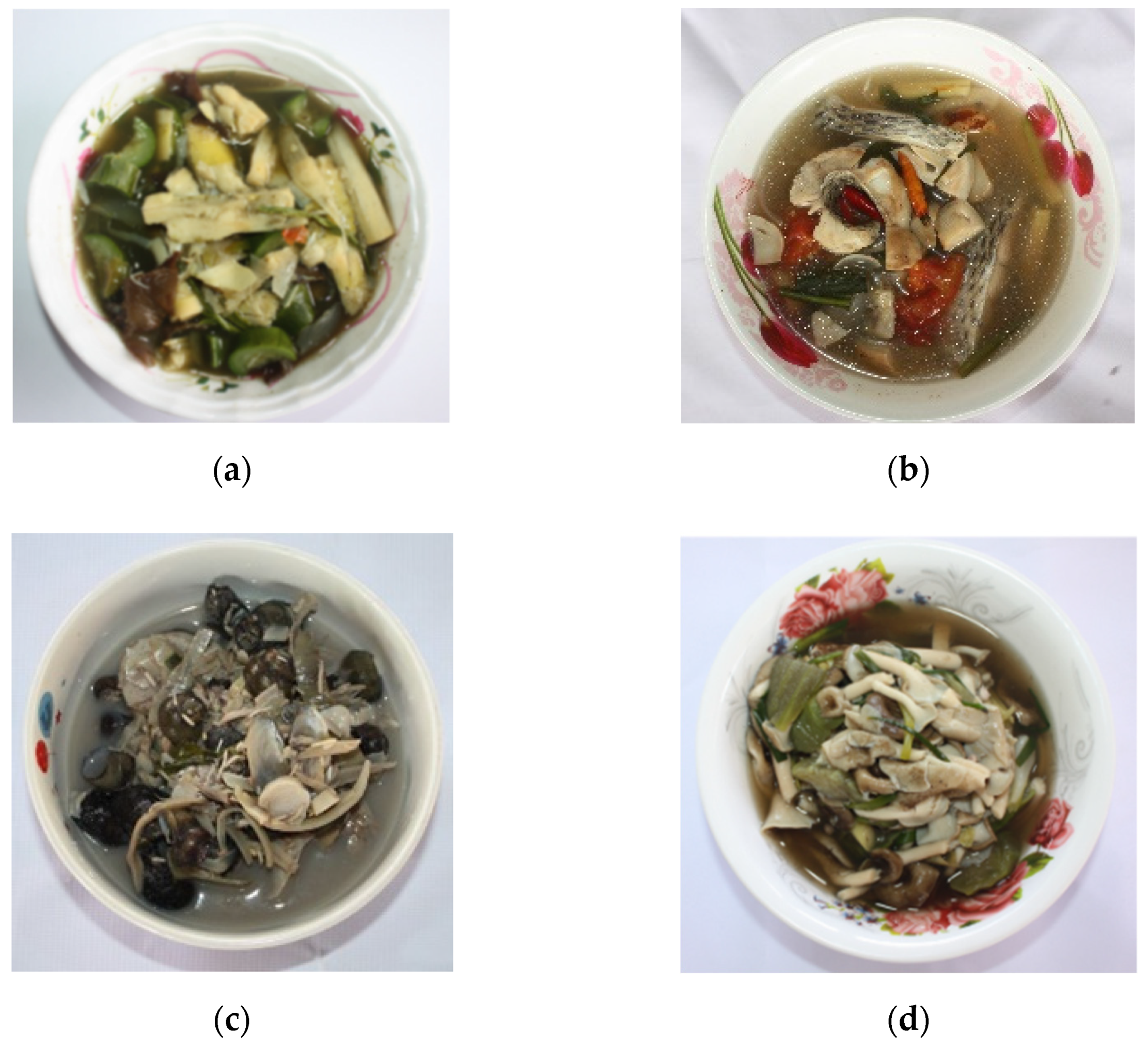
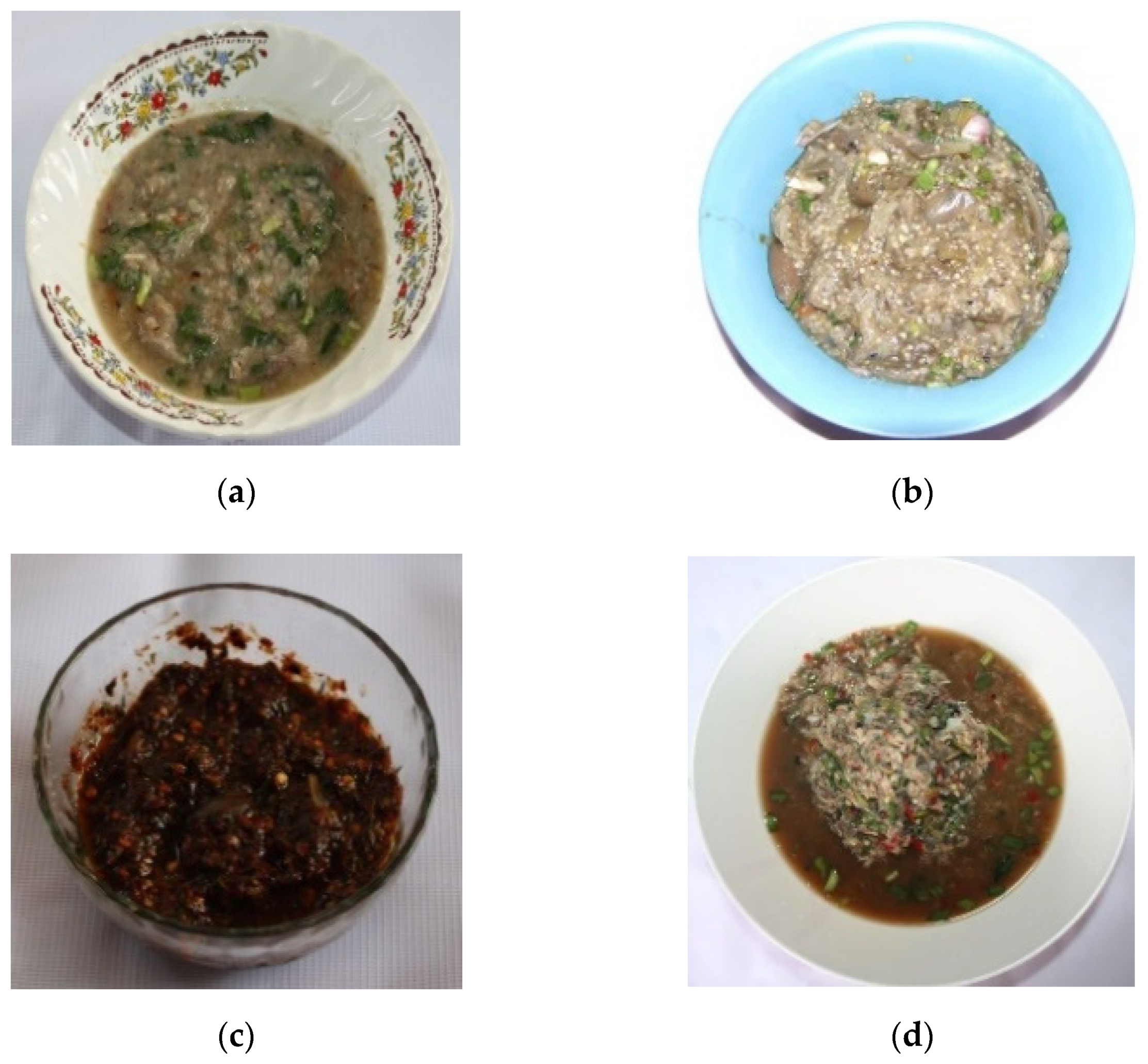

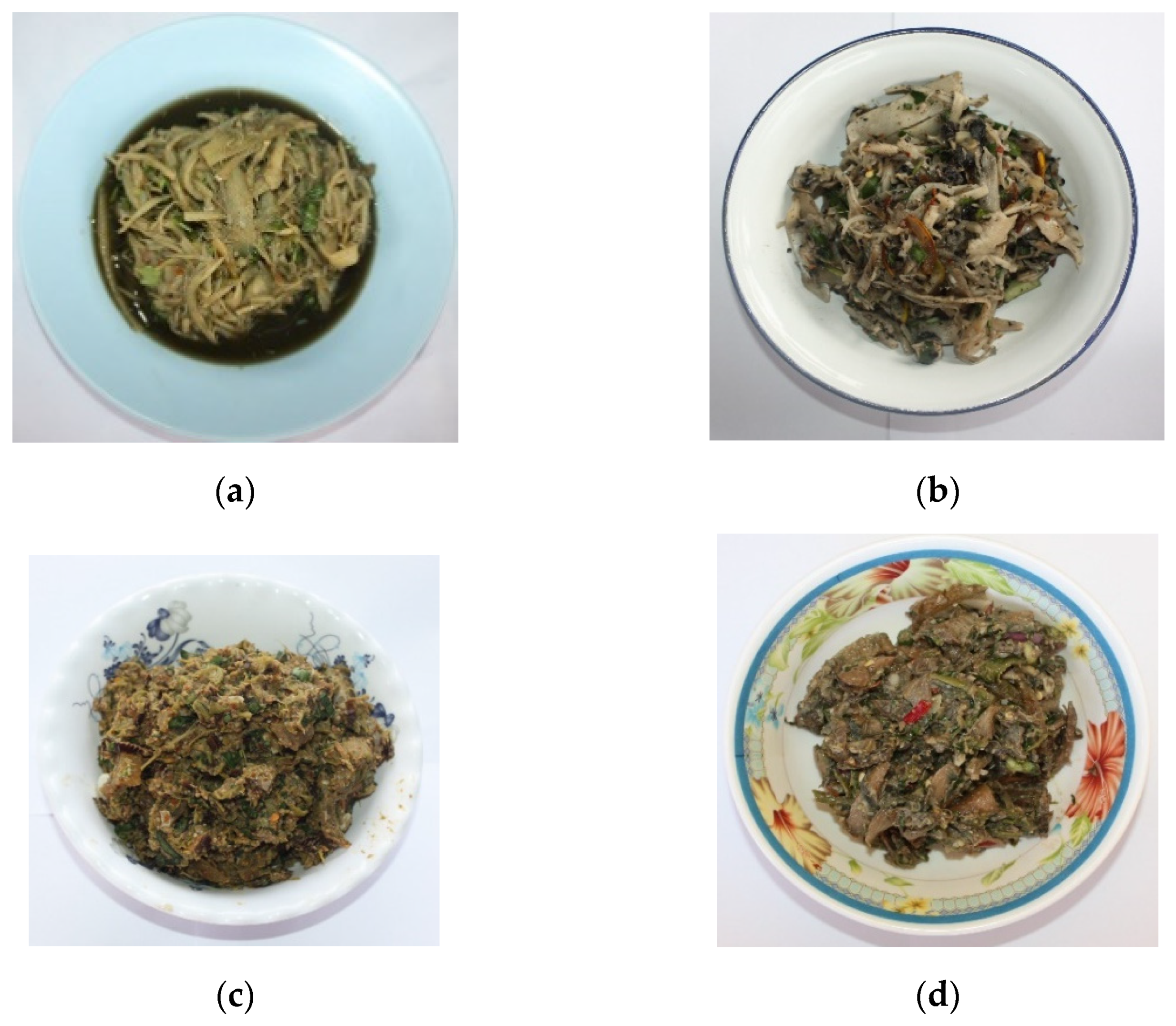
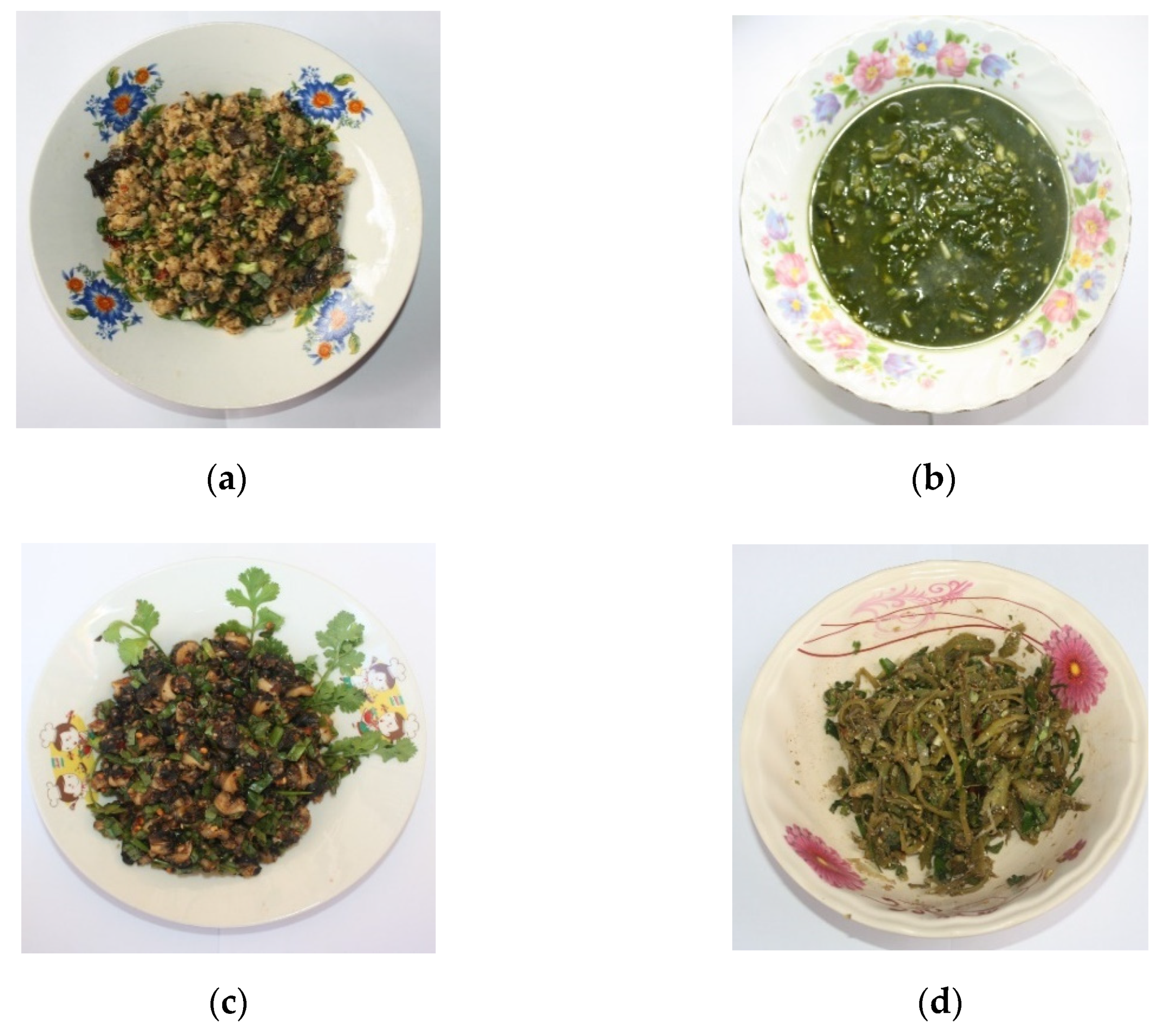
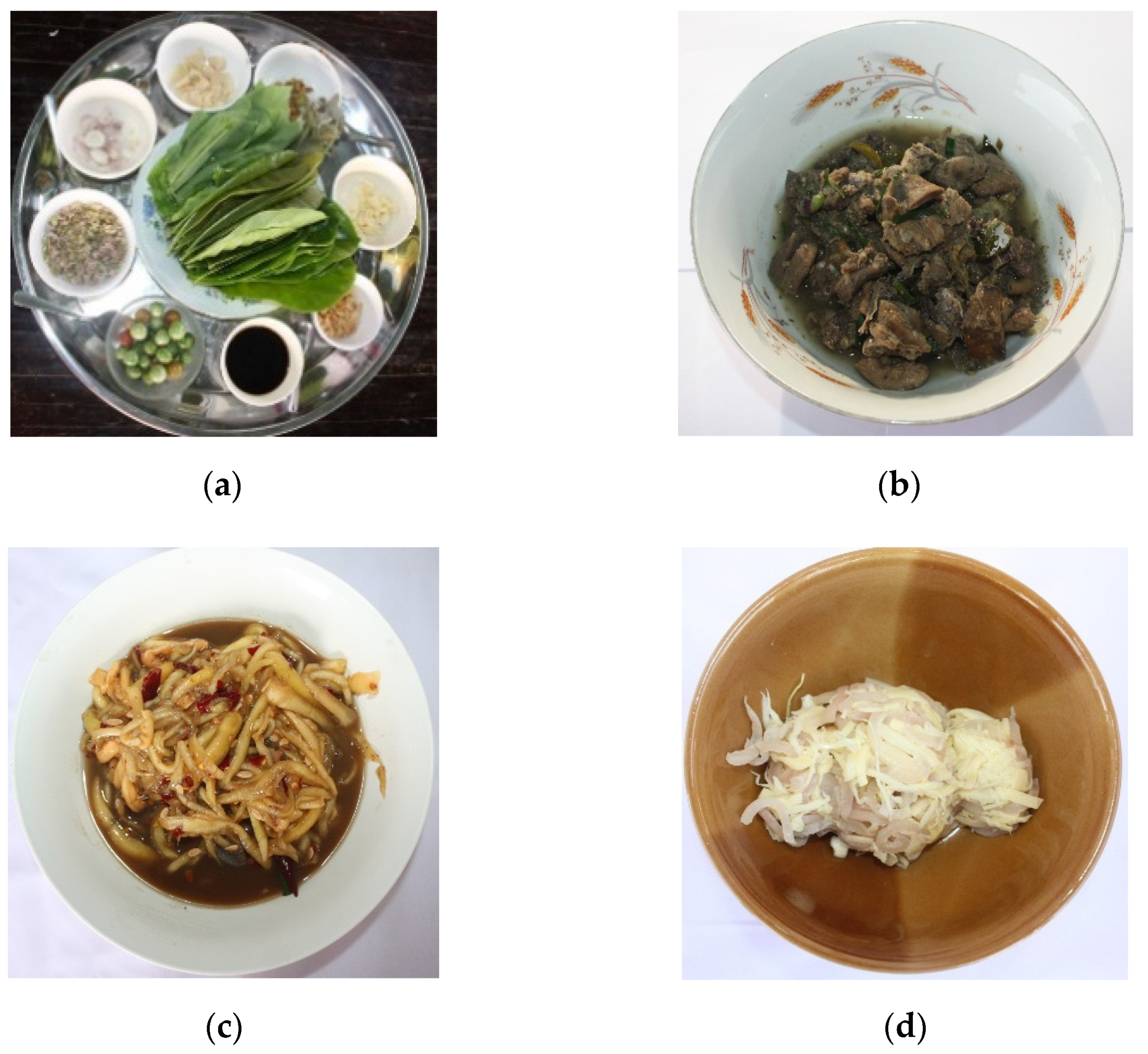
| Characteristics | |
|---|---|
| Age, mean ± SD years (min-max) | 48.2 ± 8.4 (29.0–69.0) |
| Sex, n (%) | |
| Female | 413 (97.6) |
| Male | 10 (2.4) |
| Marital status, n (%) | |
| Single | 25 (5.9) |
| Married/de facto relationship | 324 (76.6) |
| Divorce/separated/widowed | 74 (17.5) |
| Education level, n (%) | |
| No formal education | 39 (9.2) |
| Primary school | 243 (57.5) |
| Secondary school | 138 (32.6) |
| College and above | 3 (0.7) |
| Occupation, n (%) | |
| Housewife | 32 (7.6) |
| Self-employed | 71 (16.8) |
| Merchant | 39 (9.2) |
| Farmer | 269 (63.6) |
| Government officer | 5 (1.2) |
| Other | 7 (1.6) |
| Monthly income (Thai Baht), n (%) | |
| ≤3000 | 39 (9.2) |
| 3001–6000 | 243 (57.5) |
| 6001–9000 | 138 (32.6) |
| >9000 | 3 (0.7) |
| Recipe Category | n | Preparation Methods | Common Types |
|---|---|---|---|
| 1. Soup and curry | 113 | Boiling (in water without coconut milk) | Bamboo curry (kaeng nor mai); Cassia leaf curry (kaeng khee lek); Mushroom curry (kaeng hed); Snakefish-/catfish-/mackeral-/tilipia-soup (tom pla); Mussel curry (ohm hoi); Chicken soup (tom kai); Chicken curry (ohm kai) |
| 2. Dip | 40 | Grilling, boiling, grinding | Mackerel dip (jaew pla tu); Fermented fish chili dip (jaew pla la); Catfish chili dip (jaew pla duk); Tilapia chili dip (jaew pla nin); Snakehead fish chili dip (jaew pla chon); Climbing perch chili dip (jaew pla kheng); Chili dip containing fermented sathorn leaf extract (jaew dam) |
| 3. Ingredients wrapped and cooked in banana leaf | 23 | Steaming, grilling | Bamboo shoot steamed in banana leaf (mok nor mai); Fish grilled in banana leaf (mok pla) |
| 4. Pounded | 17 | Boiling, pounding | Bamboo shoot (sup nor mai); Mushroom (sup hed); Round Thai eggplant (sup makuar); Banana blossom (sup plee); Young jack fruit (sup khanoon) |
| 5. Spicy salad | 18 | Raw or cooked (boiling, grilling) main ingredient mixed with herbs, chili, roasted ground rice | Spicy broken bone fruit salad (koi peka); Spicy bamboo shoot salad (koi nor mai); Spicy mushroom salad (koi hed); Spicy banana blossom salad (koi plee); Spicy fish salad (larb pla); Spicy shellfish salad (koi hoi); Spicy chicken salad (larb kai); Spicy water silk salad (larb tao) |
| 6. Grilled | 4 | Grilling | Grilled chicken (kai ping); Grilled swamp barb (pla ping); Grilled mushroom (hed ping); Grilled buffalo skin (nang kwai jee) |
| 7. Miscellaneous | 25 | Steaming, roasting, fermenting, pickling, shredding | Steamed fish (pla neung); Pickled fish (pla som); Chicken roasted in bamboo stem (kai larm) |
| Total number | 240 |
| Recipe Category | Fish/Meat/Amphibian/Crustacean/Insect | Vegetables |
|---|---|---|
| 1. Soup and curry | Catfish, Snakehead fish; Tilapia fish; Swamp barb; Java barb; Spring eel; Goldfin tinfoil barb; Sutchi catfish; Minnow fish; Mackerel; Siamese glassfish; Fish roe; Freshwater mussel, scallop, clam, and shrimp; Rice field crab; Snail; Frog; Tadpole; Pork (meat, skin); Chicken (neck, thigh, breast, wing, offal); Buffalo skin; Beef | Banana blossom; Mushroom; Taro stem (Colocasia esculenta (L.) Schott); Climbing wattle (Acacia pennata); Lotus stalk; Banana stalk; Bamboo shoot (Thyrsostachys siamensis); Palm shoot (Arenga pinnata); Sweet leaf bush (Sauropus androgynus); Pumpkin; Young jackfruit; Cassia leaves (Senna Siamea); Horseradish; Vegetable Hummingbird flowers (Sesbania grandiflora); Water silk (Spirogyra); Sponge gourd; Ceylon spinach (Basella alba L.) |
| 2. Dip | Mackerel; Catfish; Tilapia; Snakehead fish; Climbing Perch (Anabas testudineus); Fermented fish; Freshwater crab and shrimp; Frog; Giant water bug (Lethocerus indicus); Dragonfly nymph; Cricket; Sparrow | Mushroom; round Thai eggplant; Bamboo shoot (Thyrsostachys siamensis); Rattan; Star apple |
| 3. Ingredients wrapped and cooked in banana leaf | Minnow fish; Snakehead fish; Tilapia fish; Swamp barb; Small scale mud carp; Fermented fish; Fish roe; Rice field crab; Frog; Tadpole; Cricket | Banana blossom; Pumpkin flower; Mushroom; Senna leaves; Vegetable Hummingbird flowers (Sesbania grandiflora) |
| 4. Pounded | Pork skin; Buffalo skin; Scallop | Mushroom; Bamboo shoot (Thyrsostachys siamensis); Round Thai eggplant; Snake bean; Banana blossom; Unripe jack fruit; Vegetable fern; Climbing wattle (Acacia pennata); Vegetable Hummingbird flowers (Sesbania grandiflora) |
| 5. Spicy salad | Fish; Scallop; Clam; Snail; Chicken | Broken bone fruit; Bamboo (Thyrsostachys siamensis) shoot; Mushroom; Water silk (Spirogyra); Banana blossom; Round Thai eggplant; Hermit’s waterlily (Limnocharis flava) |
| 6. Grilled | Fish; Chicken; Buffalo skin | Mushroom |
| 7.Miscellaneous | Fish; Chicken; Bull frog; Buffalo skin | Bamboo shoot (Thyrsostachys siamensis); Cantaloupe |
| Recipe Category | Aromatic and Flavour Enhancing Ingredients (Herbs, Seasonings, etc.) |
|---|---|
| 1. Soup and curry | Shallot; Garlic; Spring onion; Chili; Lemongrass; Hairy basil leaves; Coriander; Dill; Kaffir lime leaves; Fish sauce; Sodium chloride; Fermented fish sauce; Monosodium glutamate |
| 2. Dip | Roasted shallot; Roasted garlic; Spring onion; Roasted chili; Coriander; Saw-tooth coriander; Lime juice; Fish sauce; Fermented fish sauce; Sodium chloride; Monosodium glutamate |
| 3. Ingredients wrapped and cooked in banana leaf | Shallot; Garlic; Spring onion; Chili; Lemongrass; Hairy basil leaves; Kaffir lime leaves; Fish sauce; Fermented fish sauce; Sodium chloride; Monosodium glutamate |
| 4. Pounded | Shallot; Garlic; Spring onion; Chili; Sesame seed; Coriander; Saw-tooth coriander; Ginger; Galangal; Lemongrass; Kaffir lime leaves; Fish sauce; Fermented fish sauce; Sodium chloride; Monosodium glutamate |
| 5. Spicy salad | Shallot; Garlic; Chili; Ground roasted sticky rice; Galangal; Lemongrass; Kaffir lime leaves; Fish sauce; Fermented fish sauce; Lime juice; Monosodium glutamate |
| 6. Grilled | Sodium chloride |
| 7. Miscellaneous | Shallot; Garlic; Chili; Galangal; Ginger leaves; Lemongrass; Kaffir lime leaves; Spring onion; Hairy basil leaves; Fish sauce; Fermented fish sauce; Sodium chloride; Monosodium glutamate |
Publisher’s Note: MDPI stays neutral with regard to jurisdictional claims in published maps and institutional affiliations. |
© 2022 by the authors. Licensee MDPI, Basel, Switzerland. This article is an open access article distributed under the terms and conditions of the Creative Commons Attribution (CC BY) license (https://creativecommons.org/licenses/by/4.0/).
Share and Cite
Pruksa, S.; Sripoona, S.; Lowirakorn, S.; Chaitokkia, S.; Hutchinson, C. Supporting Sustainable Development by Identifying Ways to Enhance and Conserve Local Food Wisdom, Loei Province, Thailand. Sustainability 2022, 14, 6978. https://doi.org/10.3390/su14126978
Pruksa S, Sripoona S, Lowirakorn S, Chaitokkia S, Hutchinson C. Supporting Sustainable Development by Identifying Ways to Enhance and Conserve Local Food Wisdom, Loei Province, Thailand. Sustainability. 2022; 14(12):6978. https://doi.org/10.3390/su14126978
Chicago/Turabian StylePruksa, Supannee, Suwaree Sripoona, Suwalee Lowirakorn, Suradech Chaitokkia, and Carol Hutchinson. 2022. "Supporting Sustainable Development by Identifying Ways to Enhance and Conserve Local Food Wisdom, Loei Province, Thailand" Sustainability 14, no. 12: 6978. https://doi.org/10.3390/su14126978
APA StylePruksa, S., Sripoona, S., Lowirakorn, S., Chaitokkia, S., & Hutchinson, C. (2022). Supporting Sustainable Development by Identifying Ways to Enhance and Conserve Local Food Wisdom, Loei Province, Thailand. Sustainability, 14(12), 6978. https://doi.org/10.3390/su14126978









